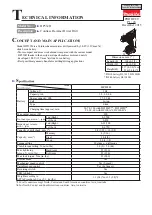
CAMINETTO - FIREPLACE - KAMINOFENS PABLO
cod. 004721548 - 10/2010
21/28
GB
d
6
usInG tHe fIrePLace
6.1
Hood rInG and connectIons (fIG. 6.2)
Place the ring (22) on the top back wall and on the side
wall, making sure that you always seal the support areas
using the refractory blend described above.
Install the Pablo hood (23) and secure it to the plate
above the oven container. Install the hood (10), being
carefully to position the ceramic fibre fumes seal
carefully. Then secure the oven hood (24) to the hood
(23) and to the oven container (10), placing the ceramic
fibre in between. Connect the fireplace to the flue with
a series of metal braces (optional), making sure you
isolate the connections to the chimney (E) and the hoods
(23) and (24) with rock wool.
Avoid horizontal sections and slopes of over 45°. If the
section of the flue differs from that of the fireplace hood,
make the connection using a conical connection so as
to avoid sharp edges or choking.
6.2
oPtIonaL fIttInG
(fig. 6.1)
Flues in aluminate steel, that can be supplied on request,
facilitate instal-lation, avoid chokes and give plenty of
guarantee of resistance to corrosion.
Ø PIPES: 20 / 25 / 30 cm
Ø BENdS: 20 / 25 / 30 cm
Ø REduCTIONS:
20 / 25 cm
25 / 30 cm
30 / 35 cm
6.3
aIr recIrcuLatIon GrILLe (fIG. 6.2)
In cases in which the combustion air outlet through the
front regulator (4) is insufficient for correct chimney
draught and there are no compartments or openings
in communication with the outside, we recommend
installing an environment air renewal grille (g) on the
counter-hood (Cc), which should be in communication
with the existing air inlet or with a specifically created new
air inlet. The grille and the relative framework are optional
elements that can be supplied upon specific request.
6.4
dryInG tHe fIrePLace
Light a small fire 5 or 6 days after installation 8 or 10
times. gradually take it up to working temperature in
order to eliminate the residual humidity and any odours
due to drying paintwork.
6
GeBraucH des KamInofens
6.1
aBzuGsHauBenrInG und verBIndunGen (aBB. 6.2)
den Ring (22) an der oberen Wand des Bodens und
an der seitlichen anbringen, stets darauf achten, dass
die Auflagebereiche mit der oben beschriebenen
zementmischung versiegelt werden. die Abzugshaube
des Pablo (23) montieren und an der darüber
befindlichen Platte des Backofens befestigen. die
Abzugshaube (10) montieren, dabei sorgfältig mit
Keramikfaser gegen Rauchasutritte abdichten.
Anschliessend die Abzugshaube des Backofens (24)
an der Abzugshaube (23) und am Backofenfach (10)
befestigen, dazwischen Keramikfaserverwenden.
Mit einer Reihe verbindungsstücken aus Metall
(zusätzlich) den Kaminofen an den Rauchfang
anschliessen, dabei müssen die verbindungen am
Kaminofen (E) und an den Abzugshauben (23 und 24)
mit Steinwolle isoliert werden.
horizontale Strecken und Neigungen über 45° sind zu
vermeiden. Falls der Querschnitt des Rauchfangs von dem der
Abzugshaube des Kaminofens abweicht, ist der Anschluss
mit einem konischen verbindungsstück auszuführen, damit
Kanten und Engstellen vermieden werden.
6.2
erHÄLtLIcHe anscHLÜsse
(fig. 6.1)
diese sind für Rauchfänge aus Aluminiumstahl auf
Anfrage erhältlich, vereinfachen die Installation,
vermeiden Engstellen und geben umfang-reiche
garantie bezüglich der Korrosionsbeständigkeit.
Ø ROhRE: 20 / 25 / 30 cm
Ø KRüMMuNgEN 20 / 25 / 30 cm
Ø PASS-STüCKE:
20 / 25 cm
25 / 30 cm
30 / 35 cm
6.3
GItter LuftumWÄLzunG (aBB. 6.2)
Falls für den einwandfreien zug des Kaminofens ein
einziger Austritt der verbrennungsluft über den vorderen
Regler (4) nicht ausreichend sein sollte und keine ins
Freie gehenden Fächer oder Öffnungen vorhanden
sind, raten wir, auf der gegenhaube (Cc) ein gitter für
die Frischluftzu-fuhr im Raum (g) anzubringen, das
mit der bereits vorhandenen Luftklap-pe oder mit einer
neuen, eigens hierfür geschaffenen in verbindung
stehen muss. das gitter und sein Rahmen sind
zusatzteile, die auf Anfrage geliefert werden können.
6.4
trocKnunG des KamInofens
5 oder 6 Tage nach der Installation wird der Kaminofen
8 oder 10 mal mit gemässigter Flamme angezündet;
stufenweise bis zur Betriebstempera-tur gehen, damit
Restfeuchtigkeit und eventuelle gerüche, die durch die
Trocknung des Lacks entstehen.








































